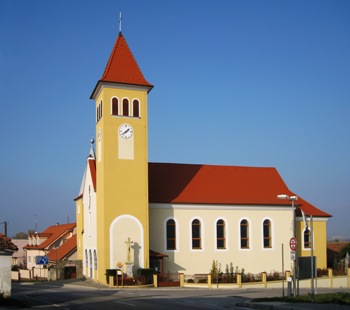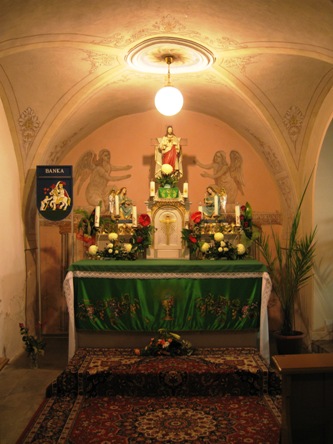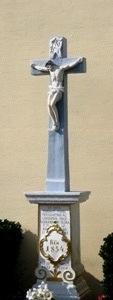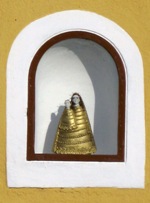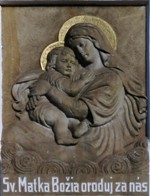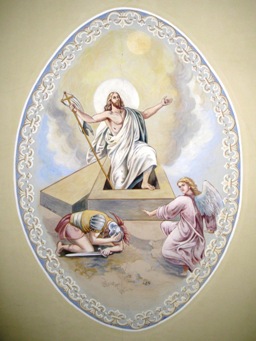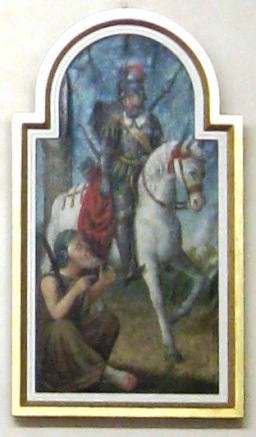 Web Content Display
Web Content Display
Kostol sv. Martina
Banka
Prvá zmienka o kostole sv. Martina pochádza a obdobia 1332 – 1337.
V roku 1599 ho pravdepodobne vypálili krymskí Tatári.
V nasledujúcom roku bol kostol opravený a kostolná loď zaklenutá renesančnou klenbou. Areál kostola bol opevnený kamenným múrom, ktorý bol zbúraný až pri prístavbe nového kostola v roku 1931. Pôvodný renesančný kamenný portál vstupu je dnes vstavaný do nového múru pred priečelím starého kostola.
Približne medzi rokmi 1581 – 1647 kostol používali evanjelici.
V roku 1779 bol pri kostole postavený kamenný kríž.
Nový kostol z roku 1930 bol pristavaný k južnej stene starého kostola, so starým je prepojený tromi oblúkmi (nesenými stĺpmi). Je to teda vlastne dvojkostol.
Z histórie kostola...
Notár Anonym spomína okolo roku 1200, že na mieste súčasného kostola stál že už deviatom storočí hrad Bana. Uvádza, že hrad stál už v čase vpádu nomádskych ugrofínsky
ch kmeňov do oblasti stredného Dunaja a na územie Slovenska. Hoci Anonymova kronika nie historicky spoľahlivý zdroj informácií, je pravdepodobné, že to naozaj tak bolo. Zrejme tu mohla stáť aj murovaná rotunda, alebo kostolík. Sú to však len dohady, lebo dodnes to neobjasnil archeologický, či historický výskum.
V druhej polovici 13. storočia začal hrad strácať svoj strategický význam, pretože sa menila obranná hranica a vybudovali sa ďalšie hrady (Branč, Dobrá voda, Čachtice a Tematín). O hrade sa píše ešte aj v roku 1263.
V súpise desiatkov pápežských kolektorov z rokov 1332 – 1337 sa na banke spomína kostol sv. Martina a farár Benedikt, ktorý zaplatil pápežským decimátorom 3 groše pápežského desiatku. Z toho sa dá usudzovať, že išlo o malú faru so 60 – 66 obyvateľmi.
Okolo roku 1516 bola fara vyňatá spod právomoci arcidiakona a priamo podriadená biskupovi. Ďalšia zmienka o Banke je z roku 1560, keď sa uskutočnila vizitácia fár ostrihomského arcibiskupstva na základe nariadenia arcibiskupa Mikuláša Oláha sídliaceho v Trnave. Vizitátor Michal Szegedi v Banke zistil, že fara nemá viac rokov farára, pričom pastoráciu vykonávajú susední farári.
Je pravdepodobné, že pri pustošení Považia krymskými Tatármi v roku 1599 bol vypálený aj kostol zasvätený sv. Martinovi na Banke. V nasledujúcom roku kostol opravili a kostolnú loď zaklenuli renesančnou (krížovou) klenbou. Areál kostola opevnili kamenným múrom, ktorý bol zbúraný pri prístavbe nového kostola v roku 1931.
Pôvodný renesančný kamenný portál vstupu je dnes vstavaný do nového múru pred priečelím starého kostola.
Do múru je zamurovaných aj niekoľko náhrobných tabúľ s latinskými nápismi datovaných rokmi 1616 a 1630. Pochádzajú z obdobia, keď kostol používali evanjelici (v Piešťanoch, do ktorej filie neskoršie patrila aj Banka, sa prvý evanjelický kazateľ Ján Vranka uvádza v roku 1581. Je pravdepodobné, že evanjelici boli v Piešťanoch už skôr).
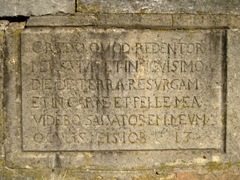 | 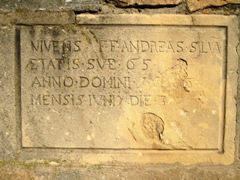 |
Neúplne zachovaný latinský z roku 1637 zamurovaný v múre kostolnej ohrady sa pravdepodobne vzťahuje na opravu alebo prestavbu kostola. Toto je jeho preklad:
TENTO POMNÍK BOL CELKOM DOKONČENÝ
V ROKU 1637 ZA CTIHODNÉHO PÁNA RAPHO PARLAGIO,
FARÁRA, PREDSTAVITEĽA FARSKÉHO CHRÁMU SLUKU.
ZA SUDCOV PÁNA JURAJA VALACHOVIČA A ŠTEFANA HOLLÉHO
ZA KOSTOLNÍKOV JÁNA, FEDORA A JURAJA KANCHO.
K šľachtickej rodine Slukovcov sa vzťahujú aj niektoré zamurované náhrobné kamene (1707) a nápis na kríži pri kostole (1779).
Kostol bol evanjelikom definitívne odňatý niekedy po roku 1647.
Po zriadení rímskokatolíckej farnosti v Moravanoch v roku 1706 patrila Banka do obvodu novej fary ako filiálka spolu s Ducovým a Hubinou.
V dokumentoch možno nájsť týchto kňazov Moravianskej farnosti, ktorí sa starali aj o veriacich na Banke:
| 1666 - 1669 | Ján Szervidy | 1764 - 1769 | Matej Kosorinský |
| 1669 - 1671 | Albert Vincenti | 1769 - 1811 | Jozef Lonský |
| 1706 - 1709 | František Dávid | 1823 - 1840 | Jozef Vendelín Bošány |
| 1709 - 1716 | Michal Blaškovič | 1840 - 1859 | Jozef Duchon |
| 1716 - 1720 | Mikuláš Nečislavský | 1859 - 1873 | Florián Némethy |
| 1720 - 1721 | Anton Vajdovič | 1873 - 1891 | Ján Bapt. Dubnický |
| 1721 - 1723 | Peter Zbornický | 1892 - 1900 | Rudolf Molnár |
| 1723 - 1728 | Štefan Raukay | 1901 - 1904 | Ján Lukáč |
| 1728 - 1748 | Jakub Peserín | 1904 - 1905 | František Vozár |
| 1748 - 1760 | Jozef Krásneč | 1905 | František Jehlička |
| 1750 - 1751 | Matej Derer | 1905 - 1932 | František Novák |
| 1751 - 1764 | Andrej Jantulík |
|
|
Matriky z celého farského obvodu (narodenia, sobáše, úmrtia) sa zachovali od roku 1783. Od roku 1895 sa vedú štátne matriky.
V roku 1779 bol pri kostole postavený kamenný kríž, ktorého donátorom bol zeman Alexander Sluka. Kríž bol renovovaný v roku 1854. Dnes už nestojí na pôvodnom mieste. Na podstavci je nápis:
EX VOTO
CURAVIT FIERI
PERILLUSTRIS AC
GENEROSUS DNUS
ALEXANDER SLUKA
7 JULII
ANNO
1779
REN
1854
SUB JU DICATU
PAULI PETRIK
Počas prvej svetovej vojny boli kvôli nedostatku kovu zhabané kostolné zvony.
Nový kostol z roku 1930 bol pristavaný k južnej stene starého kostola. Je to teda vlastne dvojkostol. Stavbu realizovala v rokoch 1930 – 1931 piešťanská firma Alexander Pflüger. Nový kostol vysvätil biskup, prvý administrátor trnavský Mons. Dr. Pavol Jantausch.
Kostol má jednoloďový ranogotický pôdorys so štvorcovým presbytériom. Exteriér kostola je hladký s oknami v tvare poloblúkov.
Na priečelí je predstavaná veža s murovanou ihlanovou strechou. V dolnej časti má úzke obdĺžnikové okno a niku.
Maliarsku výzdobu v interiéri reštauroval v roku 1989 Jozef Medo.
Na strope sú zobrazení cirkevní otcovia (sv. Albert Veľký, sv. Ambrosius, sv. Hieroným a sv. Augustín). Je tu aj sv. Michal archanjel s plamenným mečom a miskovitými váhami ako sprievodca do raja. Pri jeho nohách sa údajne nachádzal drak, ktorý pre rozsiahle poškodenie nebol reštaurovaný.
V mieste dosadajúcej klenby sú zobrazení evanjelisti. Sv. Ján a sv. Matúš sú pôvodné maľby. Sv. Lukáš a sv. Marek sú mladšie maľby od reštaurátora z roku 1989.
Starý kostol je s novým prepojený tromi oblúkmi (nesenými stĺpmi). Nový kostol má obdĺžnikovú loď s rovno uzavretým presbytériom. Zaklenutý je rovným stropom. Veža je umiestnená na juhovýchodnej strane kostola. Strecha je pokrytá škridlou.
Na priečelí kostola sú dve okná a kamenný reliéf Panny Márie s Ježiškom od akademického sochára Ladislava Ľudovíta Polláka (1912 - 2002), ktorý žil a tvoril v Piešťanoch.
Vo zvonici sú dva zvony a rapkáč na elektrický pohon. Na menšom zvone je vyobrazený sv. Martin – patrón kostola a na väčšom zvone kríž s Ukrižovaným. Na oboch sú rovnaké nápisy: „Z MILODAROV / RIM. KAT. VERIACICH BANKA / ROKU 1927" a meno firmy, ktorá zvony odliala: „LIALI BRATIA FISCHER V TRNAVE".
Na rovnom strope nového kostola je v oválnom poli znázornené Kristove zmŕtvychvstanie, menšie maľby v okrúhlych medailónoch zobrazujú cirkevnú symboliku (kríž, desatoro, kľúče, INRI, JHUS a štylizované M - Mária). Tieto maľby neboli reštaurované, obnovená bola len časť plastickej Krížovej cesty umiestnená na bočných stenách kostolnej lode.
Nad prepojením staršieho kostola je triptych – tri veľké nástenné maľby zobrazujúce Krista padajúceho pod krížom, Krista zjavujúceho sa apoštolom a veriacim a narodenie Pána Ježiša. Obrazy namaľoval v roku 1933 kňaz a maliar Alexander Buzna (1868 - 1945).
V kútoch za oltárom sú plastiky sv. Petra a sv. Pavla.
Z pôvodného oltára sa zachoval len bohostánok (tabernakulum) s plastikou Ježiša s kalichom a hostiou. Pôvodný oltár bol po II. vatikánskom koncile nahradený novým oltárom smerovaným do lode kostola. Pri jeho vyhotovení bola použitá pôvodná oltárna menza s plastickým vyobrazením pelikána živiaceho mláďatá vlastnou krvou. Pelikán je symbolom Ježiša, ktorý preliatím vlastnej krvi spasil svet.
Pôvodný je aj obraz sv. Martina v brnení na koni so žobrákom, ktorý má podobu Ježiša. Podľa tradície sv. Martin dal svoj plášť uzimenému žobrákovi. Podľa evanjelia si Ježiť tak váži, keď pomáhame svojim blížnym v núdzi, ako keby sme pomohli samému Ježišovi. Tieto dve myšlienky sú spojené do jedného výjavu na obraze.
Viac o histórii Banky nájdete na webových stránkach obce.
Použitá literatúra:
Ľudovít Chmelár-Hlohovský: Piešťanský dekanát. Magma, 2003, 58-59
Marián Klčo, Vladimír Krupa: História Banky, 1. - Od praveku do roku 1918. Obecný úrad Banka, 2004
 Kostoly farnosti
Kostoly farnosti
Piešťany
- Kostol sv. Cyrila a Metoda
(Nitrianska ulica) - Kaplnka Božského Srdca Ježišovho
(kúpeľná kaplnka pri sklenenom moste, Winterova ulica) - Kaplnka Sedembolestnej Panny Márie
(pri dome SJ, Poštová ulica) - IX. základná škola (Sv. omše sú dočasne zrušené!!!)
(sídlisko Adam Trajan, ulica E. F. Scherrera)
Filiálka Banka
Filiálka Kocurice
 Web Content Display
Web Content Display
